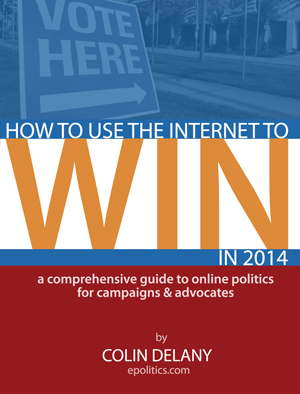The following is an excerpt from “How to Use the Internet to Win in 2014: A Comprehensive Guide to Online Politics for Campaigns & Advocates”, available for download on Amazon.com and here on Epolitics.com.
From the “Mobilization and GOTV” Chapter
Motivating Donors and Volunteers
If political support ultimate comes down to emotion — how a potential donor or volunteer feels about a candidate, race or issue — each contact people have with a campaign influences their propensity to give time or money. Every interaction matters: their experience at an in-person event or a storefront office, what they see online, the ads on their TVs and radios, and of course any direct communications they receive via email, Facebook, Twitter, phone or direct mail. Successful online organizers realize that they are essentially managing virtual relationships with many people at once.
Like any friendship, a political relationship that heads downhill can be hard to salvage (disillusioned donors are unlikely to open their wallets again), and unless a campaign is entirely short-term and doesn’t mind burning bridges, properly managing and motivating supporters over the course of a race will be paramount. List size matters, and campaigns should take every opportunity to grow their own, but list response is just as important, since a relatively small number of motivated people can outperform a much larger group whose members don’t have much coordination or reason to care.
One excellent way to turn people away over time is to treat them like cash machines, something that’s entirely too easy for political professionals to do. In fact, early in the 2008 Obama campaign, manager David Plouffe frequently had to mediate between a fundraising team eager to maximize short-term revenue and a new-media team with an eye on the long game.
At a basic level, not every communication from the campaign should ask for money. Instead, campaigns should think of ways to provide value to supporters in the form of news, personal connection, information and giveaways, as well as of non-monetary ways supporters can contribute. Getting people to recruit ten friends via email, for instance, is an easy way for them to participate without having to part with a dime — and once they’ve taken that action, they’re more involved and committed than they were the day before.
The Ladder of Engagement
A common approach to supporter management is to provide activists with escalating levels of involvement. Like a the rungs of a ladder, each higher engagement level requires more work and holds fewer people, but it ideally also creates more value for the campaign or cause. Over time, list managers will obviously try to move people to higher tiers, converting casual list-members into donors, donors into volunteers, and volunteers into precinct leaders. With a sophisticated CRM, campaigns can get creative in how they track supporters, noting the most reliable activists in the database and putting these “super-volunteers” to work in ways that use their skills, connections and time.
Tiers of engagement work in the other direction as well — if you’re planning a social media-style create-a-video contest, for instance, find a way to involve people who AREN’T actually doing the shooting and editing, perhaps by asking them to rate or comment on the submissions. The overall goal: keep the most casual supporters working at a basic level, while also providing more strenuous outlets for the smaller core of true activists.
More Than Money: Mobilization Means Votes
Political campaigns often focus on wringing donations out of their online supporters (and we’ll discuss online fundraising in depth in a later chapter), but real people are are worth more than just the contents of their bank accounts — smart campaigns will try to tap their brains and time as well (mmmm, brains….). The 2008 and 2012 Obama campaigns relied on volunteer enthusiasm to a remarkable degree, with hundreds of thousands of people downloading “walk lists” of houses to visit in their neighborhoods and phone numbers to call. They reported the results of their outreach work through a comprehensive grassroots data collection system, in turn giving the leadership priceless data about how the campaign was playing out at a neighborhood level.
This kind of sophistication has been out of the reach of most state- or local-level campaigns (a situation that’s rapidly changing), but regardless of your level of technical sophistication, you can still use online communications to mobilize the masses to perform just about about every traditional political task — and plenty of new ones, too. Among other things, campaigns can ask people to:
- Show up for in-person events (rallies, house parties) and invite friends and family.
- Volunteer at local offices.
- Phone-bank, either at a campaign office or over their own cell phones (virtual phone-banking).
- Connect with their neighbors door-to-door (canvass).
- Spread the word about a fundraising push.
- Recruit friends via email, Facebook or Twitter, or Like/Share/Comment on campaign content.
- View a YouTube clip, infographic blog post or other online content and spread it virally (social media profiles = “virtual yard signs”).
- Put up (actual) yard signs.
- Create content such as blog posts, Tweets or online videos all on their own.
- And of course, vote!
The importance of that last bullet cannot be overstated for down-ballot candidates, particularly if they’re trying to buck a national trend in their own districts. The upcoming chapters on Field Organizing and Data/Analytics go into detail on how a modern, data-driven grassroots operation can make a real difference on Election Day.
…
Want more? Get your copy of “How to Use the Internet to Win in 2014” today.

